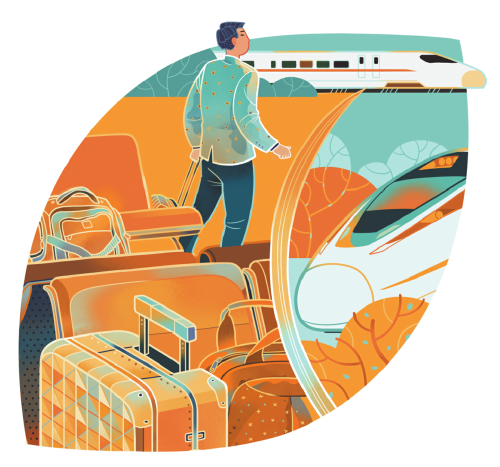逆向春运是一种旅游模式的范式转变 - 2024-02-07

The Spring Festival travel rush, known as chunyun in Chinese, reflects a broader social phenomenon and is a unique transportation challenge that China faces. Characterized by the heavy, uni-directional flow of urban residents returning to their hometowns before Spring Festival for the family reunion on the eve of the Lunar New Year, chunyun creates lots of challenges for the transportation networks including the railways and airlines.
These challenges have long been considered insurmountable. But recent years have seen a quiet shift in the traditional way of celebrating Spring Festival, especially among young professionals working in major cities, who have been using "reverse chunyun" to avoid the one-way travel rush.
Faced with the difficulty in obtaining tickets for travel back home during chunyun, these young professionals are no longer fixated on spending time and money on visiting their hometowns. Instead, they take advantage of the relatively easy availability of tickets on trains and flights bound for major cities. They capitalize on the discounts offered on major city-bound flights and trains to bring their parents to the cities from their hometowns to celebrate the Lunar New Year with them, or go on vacation with family and friends as part of group tours.
According to the Guangdong Railway Group, during the 2024 Spring Festival travel rush, Guangzhou and Shenzhen are not only popular departure points but also popular destinations, with reverse travel during the Spring Festival travel rush gradually becoming a new trend. On Jan 30, the first five days of the Spring Festival travel rush, the number of arriving passengers at major railway stations in Guangdong reached 4.38 million, an increase of over 80 percent compared to the previous year.
Of late, the Guangzhou Railway Group has been offering multiple discounts on long-distance train tickets for reverse chunyun, further boosting the trend. This shift underscores a change in the traditional migration pattern and traditional customs of the Chinese people.
The emergence of reverse chunyun can be attributed to the escalating marginal social costs associated with the traditional chunyun model. Additionally, the development of the internet and proliferation of smart transport apps have made social interactions easier and increased people's travel choices. As society progresses, changes in values and lifestyles are bound to happen, influencing the way in which we celebrate Spring Festival. To be sure, reverse chunyun yields significant socioeconomic benefits.
First, thanks to reverse chunyun, many major cities don't look deserted during the Spring Festival holiday, ensuring the normal supply of labor, goods and services.
Second, the alternative modes of family reunion, such as video calls, have contributed to the changes in the vacation pattern.
Third, people's urge to travel abroad during holidays is gradually changing the traditional way people used to attend the family reunion on the eve of the Lunar New Year, which in turn has not only changed the demands associated with travel but also boosted the tourism industry.
And fourth, reverse chunyun has eased the pressure on transport networks during Spring Festival.
The changing phenomenon reflects societal progress. The gradual change in the way people spend their holidays and celebrate Spring Festival is conducive to not only optimizing the allocation of social resources but also social development, and therefore it should be encouraged.
The Spring Festival travel rush is both a challenge and an opportunity. People's travel demand remains strong, both for family visits and tourism, with the period being marked by cross-border, inter-provincial, intercity and urban-rural travel.
In terms of passenger distribution, driven by the popularity of ice and snow tourism in Northeast China, cities such as Harbin of Heilongjiang province experienced a significant increase in Spring Festival passenger traffic compared with the previous year. Some agencies' data analyses show the top 10 destinations for Spring Festival air travel are Chongqing, Harbin, Guiyang, Beijing, Chengdu, Kunming, Xi'an, Guangzhou, Changsha, and Shanghai. Harbin climbed from the 16th to the second place on the popularity list, becoming a new Spring Festival tourism hotspot. Search for high-speed rail and flight tickets from major cities like Beijing, Shanghai, Guangzhou and Shenzhen to Harbin, too, increased significantly compared with the previous year.
There is also a strong demand for intercity high-speed rail travel among major urban clusters, primarily driven by those visiting their hometowns and traveling to nearby places on vacation. Hence, there is need to develop intelligent transport services, and open new high-speed flight and train routes, and add more long-distance buses to meet the growing diversified travel demand.
The government, on its part, should further integrate transportation network resources, strengthen the coordinated scheduling and command of various transport modes, enhance seamless transfer mechanisms, improve the interconnectedness of Spring Festival travel services, create an efficient travel service supply chain, and take measures to ensure the high-quality development of Spring Festival travel services.
By effectively employing policy guidance and market regulations, optimizing transportation organization plans and market pricing mechanisms for reverse chunyun, and providing appropriate subsidies to transportation companies for opening new passenger routes during reverse chunyun, especially connecting flights and high-speed rail services, the government can help boost both socioeconomic benefits and transport companies' profits.
It is thus imperative that government departments and transportation companies continue to closely monitor the Spring Festival travel rush, including capacity allocation, emergency safety measures, service quality and fare levels, by collecting supply and demand data on reverse chunyun passengers, summarizing experiences and analyzing the emerging patterns, in order to provide smart, safe and smooth experience for passengers during Spring Festival.
The authors are Jia Yuanhua and Ma Jihui. Jia Yuanhua is a professor of transportation engineering at the School of Traffic and Transportation, Beijing Jiaotong University; and Ma Jihui is a professor of civil aviation transportation at the same university.
Source: China Daily
